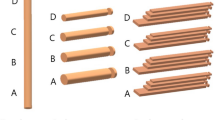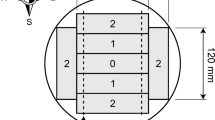Abstract
The aim of the study was to model and analyse the effect of length on grade yield of timber from different stem parts in Picea abies, and to use the models to simulate the cost of reduced grade yield due to increased length. The boards were simulated having lengths ranging from 20 to 60 dm starting at stump level, 4 m above stump level and 8 m above stump level, respectively. Logistic regression models showed that length had a significant effect on grade yield, and this length effect was stronger in strength grading according to INSTA 142 (IN) compared to appearance grading according to Nordic Timber (NT). The length effect was most pronounced in butt logs, and somewhat greater in middle logs compared to top logs. Also a smaller length effect in inner boards compared to boards farther from the pith was found for IN-grading. The cost of the decrease in grade yield with increasing length will depend on the assumptions about the price gap between the grades. Current market prices in both grading rules gave a decrease in value of the sawn timber in stock by about 6% with an increase in the log length from 45 to 60 dm. In addition, a decrease in yield of timber in longer logs will amplify this effect, while a higher efficiency in the production process will diminish it.
Zusammenfassung
Ziel dieser Untersuchung war es, den Einfluss der Länge auf die Ausbeute von Fichtenschnittholz aus verschiedenen Stammabschnitten in den einzelnen Sortierklassen zu modellieren und zu untersuchen und mit Hilfe der Modelle die Kosten des Ausbeuteverlustes aufgrund zunehmender Länge zu simulieren. Für die Simulation wurden Bretter von 2 bis 6 m Länge aus drei Stammhöhen (Fällschnitt, 4 m, 8 m) verwendet. Spezielle Regressionsmodelle zeigten, dass die Länge einen signifikanten Einfluss auf die Ausbeute in den Sortierklassen hatte und dass dieser Längeneinfluss bei der Festigkeitssortierung gemäß INSTA 142 (IN) stärker ausgeprägt war als bei der Sortierung nach dem Aussehen gemäß Nordic Timber (NT). Der Längeneinfluss trat am deutlichsten in den Erdstammstücken hervor und war im mittleren Stammabschnitt größer als im Zopfstück. Darüber hinaus war der Längeneffekt bei der Festigkeitssortierung bei marknahen Brettern geringer ausgeprägt als bei markfernen Brettern. Die Kosten einer sinkenden Ausbeute in den Sortierklassen aufgrund zunehmender Länge hängen von den angenommenen Preisscheren zwischen den Sortierklassen ab. Auf der Basis der derzeitigen Marktpreise führt ein Anstieg der Länge von 4,5 auf 6 m bei beiden Sortierverfahren zu einer Wertminderung von insgesamt 6%. Daneben wird dieser Effekt durch eine Abnahme der Schnittholzausbeute bei längeren Stammabschnitten verstärkt, wohingegen die höhere Produktionsleistung diesen mindert.
Similar content being viewed by others
References
Anonymous (1976) Guiding principles for grading of Swedish sawn timber: elaborated by the Timber Grading Committee of 1958. Swed Timber Wood Pulp J
Anonymous (1981) Grading rules for sawn timber: as practiced by Østlandets Skurlastmåling. Norwegian Institute of Wood Technology, Oslo (in Norwegian)
Anonymous (1994a) Handbook: Grading and scaling regulations for coniferous sawlogs. Tømmermålingsrådet, Ås (in Norwegian)
Anonymous (1994b) Nordic Timber. Grading rules for pine (Pinus silvestris) and spruce (Picea abies) sawn timber: Commercial grading based on evaluation of the four sides of sawn timber. Treindustriens tekniske forening, Oslo
Barrett JD, Fewell T (1990) Size factors for the bending and tension strength of structural lumber. In: CIB W18 Meeting twenty-three, Århus, Denmark
Blomqvist H, Nylinder M (1988) Relation between geometry, yield and quality for sawlogs of spruce: results of investigations at Rockhammar sawmill. Swedish University of Agricultural Sciences, Department of Forest Products, 202 (in Swedish with English summary)
Dalen R, Høibø OA (1985) Connection between quality graded sawlogs and sawn timber quality. Master thesis, Agricultural University of Norway, Ås (in Norwegian)
EN 384 (2004) Structural timber – Determination of characteristic values of mechanical properties and density
EN 1611-1 (2000) Sawn timber – Appearance grading of softwood – Part 1: European spruces, firs, pines and Douglas fir
Haugen JV (1996) Connection between log quality and sawn timber quality. Master thesis, Agricultural University of Norway, Ås (in Norwegian with English summary)
Høibø OA (1991) The quality of wood of Norway spruce (Picea abies (L.) Karst) planted with different spacing. Doctoral thesis, Agricultural University of Norway, Ås (in Norwegian with English summary)
INSTA 142 (1997) Nordic visual strength grading rules for timber
Isaksson T (1999) Modelling the variability of bending strength in structural timber – Length and load configuration effects. Doctoral thesis, Lund University, Lund
Lam F, Varoglu E (1990) Effect of length on the tensile strength of lumber. For Prod J 40(5):37–42
Madsen B (1990) Length effects in 38 mm spruce-pine-fir dimension lumber. Can J Civ Eng 17:226–237
Moberg L (2001) Models of internal knot properties for Picea abies. For Ecol Manag 147(2/3):123–138
Müller M (1984) Connection between log quality and sawn timber quality: results from a pilot study. Norwegian Institute of Wood Technology (in Norwegian)
Orvèr M (1973) A comparison between some marking alternatives for cross cutting for Scots pine stems. Skogshögskolan. 84 (in Swedish with English summary)
Rikala J (2003) Spruce and pine on drained peatlands – wood quality and suitability for the sawmill industry. Doctoral thesis, University of Helsinki, Helsinki
Rouger F, Barrett JD (1995) Size effects in timber. In: Blass HJ, Görlacher R, Steck G (eds) Grundlagen Entwicklungen Ergänzungen STEP 3: Holzbauwerke nach Eurocode 5. Fachverlag Holz, Düsseldorf
Rouger F, Fewell T (1994) Size effects in timber: Novelty never ends. In: Görlacher R (ed) CIB – W18: Meeting twenty-seven. Sydney, Australia
Vestøl GI, Høibø OA (2001) Prediction of knot diameter in Picea abies (L.) Karst. Holz Roh- Werkst 59(1):129–136
Weibull W (1939) A statistical theory of the strength of materials. Royal Swedish Institute for Engineering Research
Øvrum A, Vestøl GI, Høibø OA (2008) Modeling the longitudinal variation of sawn timber grades in Norway spruce (Picea abies (L.) Karst.). Holz Roh- Werkst 66(3):219–227
Author information
Authors and Affiliations
Corresponding author
Rights and permissions
About this article
Cite this article
Øvrum, A., Vestøl, G.I. Modeling the effect of length on yield of sawn timber grades in Norway spruce (Picea abies (L.) Karst.) . Eur. J. Wood Prod. 67, 63–70 (2009). https://doi.org/10.1007/s00107-008-0286-9
Published:
Issue Date:
DOI: https://doi.org/10.1007/s00107-008-0286-9




